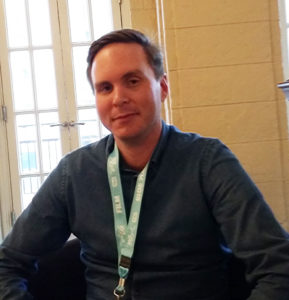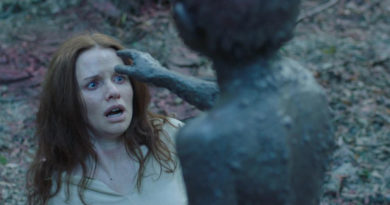SXSW 2018 Film Interview: Human Rights Filmmaker Jason Outenreath
Making its world premiere at this year’s SXSW was the feature-length documentary They Live Here, Now, conceived and directed by human rights filmmaker Jason Outenreath. Shot on location at Casa Marianella, an emergency homeless shelter in East Austin, it depicts the daily lives of recently arrived immigrants as they relate their frequently harrowing stories about their journeys to the United States.
With this film, Outenreath pushed the boundaries of the documentary format by blending actual portraits of immigrants who live at Casa Marianella with scripted characters who were drawn from real life. Here, he explains the reasons for this unorthodox approach.
Your feature-length documentaries, They Live Here, Now and Country Kids, as well as a number of your short films, have focused on immigration. Can you tell us about why this is frequently your subject?

I was a Peace Corps volunteer in Nicaragua for a couple of years. I studied in Mexico, and I also lived there afterward. I developed close relationships with the people there. When I came back to the U.S., I sought out groups that were immigration-oriented. As a filmmaker, I felt a social responsibility to respond to what was happening and how people were being treated. Immigrants deserve to be treated with the same dignity as any other human being.
How did you locate Casa Marianella?
I was a student at the University of Texas at Austin. Someone in passing mentioned Casa Marianella to me and said, “You might be interested in this place.” I began visiting it on a fairly regular basis, not with a camera or anything, but I was just blown away by the community and the diversity of people coming there. When I was pitching my project to them, it involved talking to the entire house, just standing in front of immigrants from 20 or 30 countries.
It was something that left a really deep impression on me. As I realized the gravity of this place in Austin that deserved more attention for the services it was providing, it also needed to be celebrated for the immigrants and what they had gone through to get there.
How long did it take to secure the subjects and make the film?
It took about three and a half years. I make relationship-based films, and I’m very concerned with the connections I make. So I spent the first year, you might say, in preproduction, forging those relationships and learning about the house before I began filming at all. The editing process took about a year and a half to complete, and I edited it myself.
Were there some people who were afraid to come on camera and tell their stories?
Yes, they were divided along two lines. There were a lot of people who didn’t want to appear on camera or who were very afraid of what that would mean to their legal status or their families in their home countries. At the same time, there were also people who wanted to be heard. My job as a filmmaker was to work with the people who wanted to share their stories while also respecting their privacy.
I didn’t set out to make a political film, but I have my political ideas, and they’re embedded in it. I think it goes back to the respect that people deserve, regardless of where they’re from or what their circumstances are.
In terms of adding the narrative story to the piece, what was the purpose?
There were two main goals I had with interweaving that story. As a documentary filmmaker, one of the questions that I ask is, “What constitutes social reality?” I’m always interested in pushing the boundaries and asking both myself and the audience, “What really is documentary?” I had artistic reasons for doing it, too, and it does enrich the story of Casa Marianella.
I had ethical reasons as well. I wanted to show aspects of the house that were essential to that experience, but I couldn’t get conversations with lawyers and recent arrivals who just came to the house. Those are things you just can’t film without putting someone’s actual legal status at risk, so they were some of the reasons I decided to weave in the fictional narrative.
The storyline of the fictional character [Nayeli] would have been impossible to film without the reality of the house and the reality of the people she was interacting with. She was a composite character of a lot of people I’d met, working at the border and living in Mexico and Nicaragua. The actress [Regina Casillas] brought a lot to the role. I feel like I’ve met that character before.
She blends quite well into the film, too.
Right. Nobody was told that she was an actress. I wanted it to appear as if she was coming to Casa Marianella for the first time. She went through all the actual steps that someone would go through to be taken in. I had in mind the arc for her story, but a lot of the scenes were improvised. I just gave general direction, like, “You’re going to cook rice,” and she would say, “I don’t know how to do that,” and I would say, “Figure it out.”
What do you want to inspire in viewers who see the film?
I’d like people to identify with the immigrants in it who were brave enough to share their really personal stories. Hopefully, they’ll take a stake in the next chapter of this story, since it’s not really a culminating project so much as it is ongoing. I hope people will watch it and think, “I really need to do something about this. I need to be a part of the solution.”
It’s obvious you’re going to continue to tell these stories.
Right. I wouldn’t say solely immigration, but I can see myself continuing in the specific vein of human rights films. I feel a very strong need to use filmmaking to tell humanizing stories about people.
Where is They Live Here, Now going next?
That’s in process at the moment. I’d personally love to see it shown in schools and educational institutions. It’s so important to humanize the issue, especially with younger generations, since they are the people who will be making some of the decisions in the future.
The PBS documentary series Independent Lens would be a great place, too.
Absolutely. Other festivals as well.
What other projects do you have in development?
I’m working on my first fiction feature film, which I’ll be shooting this summer. I’m also working on a web series about the indigenous cultures of Oaxaca, Mexico.




